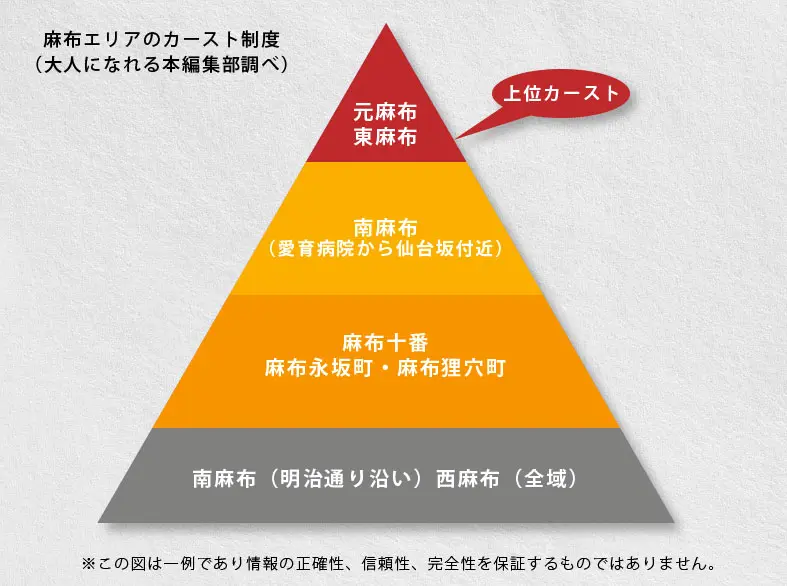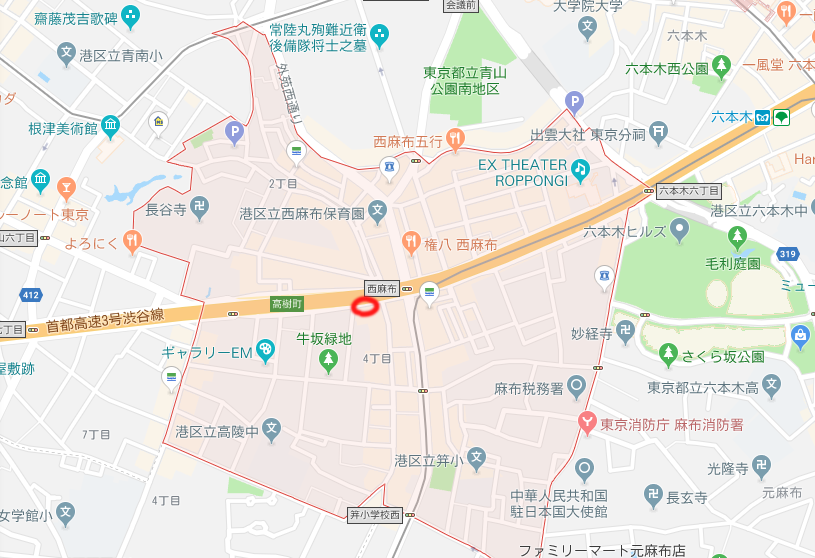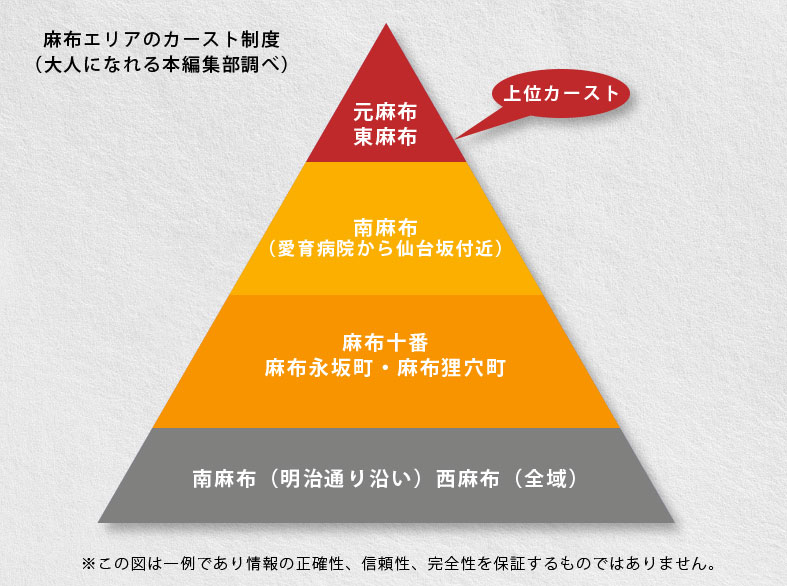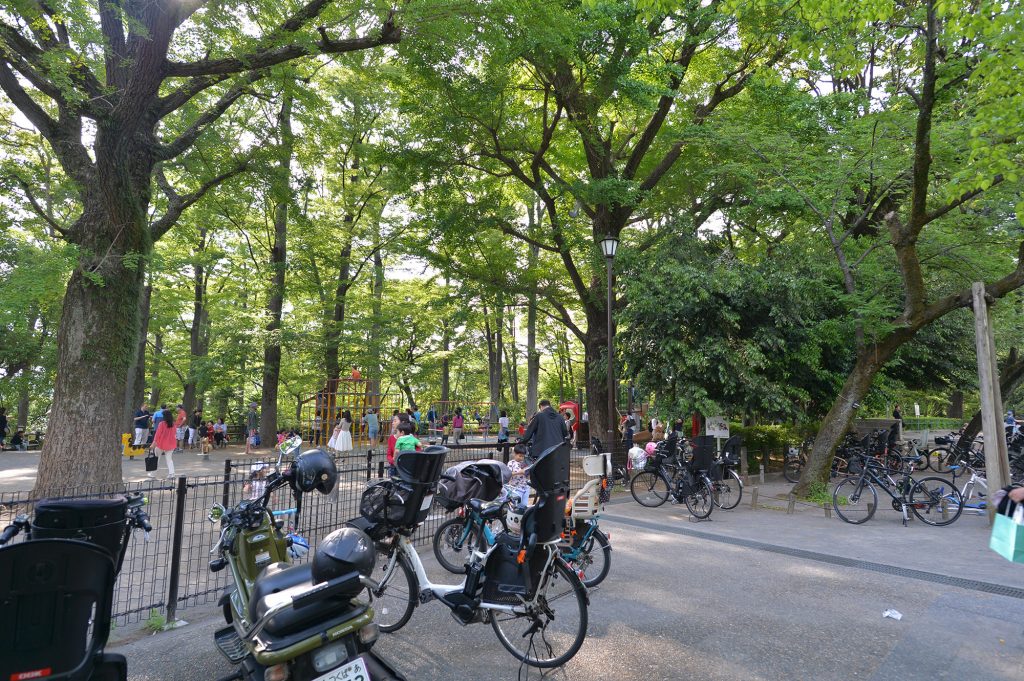Nishi-Azabu” is often talked about on the Internet.
If you live in the city, you may be familiar with it, but if you live in a rural area, you may not know what it is. Now that I have moved from Shizuoka to Minami-Azabu, I would like to write about the atmosphere of the area and what Nishi-Azabu is.
What is Nishiazabu?
You might be thinking, “It’s a gorgeous town that’s been featured in a magazine,” but in reality, it’s a very plain town.
(Photo taken from the point circled in red on the map, looking toward Takagi-cho)
It’s surprisingly bleak, with only an embassy of a country I’ve never heard of on the left, the newly renovated Seijo Ishii, a 7-Eleven, and an eel chain restaurant.
It’s not a prosperous street like Omotesando or Harajuku, but a mysterious area where somehow only the name of the place is walking by itself.
Where is Nishi-Azabu?
Until I came to the city, the location of the “Azabu area” itself was vague. I only thought it was near Roppongi. Although Nishi-Azabu is in Minato Ward, it is only 5-10 minutes away from Shibuya Station by cab, 15-20 minutes by bicycle, or a little over 30 minutes on foot.
Specifically, it is surrounded by Minami Aoyama, Roppongi, Hiroo, Minami Azabu, and Moto Azabu.
To put it crudely for those who don’t live in Tokyo, it is located between Shibuya, Ginza, and Shinagawa. The image of this area is that of a fashionable town with many restaurants and surrounded by Aoyama, Omotesando, and Roppongi.
In fact, the caste system persists in the Azabu area, and the atmosphere of the town and the people who live there are completely different.
Motoazabu” and “Higashi Azabu” are at the top of the caste system. Land prices are higher in Motoazabu, and if a large piece of land is put up for sale, the price will be as high as 5-9 million yen per tsubo. The land price in Motoazabu is much higher than that of Azabu Juban, which ranges from 2 million yen to 4 million yen.
Motoazabu is located on a hill and is a quiet residential area. The separation of buildings on the land is large, and there is a series of mansions with more than 300 square meters to spare. Just to build a small house, you would need to spend 200 to 300 million yen for the land.
Higashi-Azabu is an unassuming area, but I put it in the upper caste just in case there are only the original landowners or people who should not be mentioned casually. The redevelopment of the area has been neglected, and there are few apartments, only old-fashioned single-family houses. No restaurants, no coffee shops, just quiet.
Next is the area around Sendai-zaka and Aiiku Hospital in Minami-Azabu. Like Motoazabu, this area is also located on a hill and is a quiet residential area. There is little traffic, lots of greenery, and spacious houses with gardens. It is also located near Arisugawa Memorial Park, one of the largest parks in Tokyo, making it a rare place that combines the convenience of the city center with the luxury of being surrounded by greenery.
Arisugawa Memorial Park
Azabu Juban is a shopping district, close to Roppongi, with an abundance of restaurants and stores. However, it is not a place to live. The streets are very crowded, the cars are many, and the roads are narrow. If you are used to holidays, you will get tired of being overrun by tourists.
The lowest caste is the area around Furukawa-bashi, which is not really called Minami-Azabu (no one even recognizes it as the Azabu area anymore), and the whole Nishi-Azabu area.
The area around Arisugawa Memorial Park in front of Hiroo Station is upscale, but the area facing Shirokane and Takanawa was originally an industrial area.
Shirokane and Azabu in Tokyo’s Minato Ward were once a major industrial area… Azabu Juban was a “flower town” https://biz-journal.jp/2018/06/post_23792.html
The area along the old river to the south was an industrial area, and the river flowed east to the oceanfront (Shibaura, etc.), which was also a large industrial area. Even though Shirokanedai is a hill and a celebrity, Shirogane is a lowland and was a factory area. Part of Azabu-ku is also along the old river, and the southern end of Minami-Azabu is along the old river, where there are still small factories, warehouses and public baths. (Quoted in part from Business Journal)
The Shirokane side of Minami-Azabu was originally an industrial area, with day laborers working in factories and all kinds of metal processing and automobile-related factories. Even now, there are a few factories left and you can feel the atmosphere. The part of Minami-Azabu along the dirty Furukawa Bridge is a low caste area, with a lot of single apartments and investment apartments.
The Nishi Azabu of the title is another area that cannot be called a high class residential area.
The caste system is still very much in place, so if you think you’re cool living in Nishi Azabu, you’ll be exposed as a country bumpkin. It’s best to keep your mouth shut even after you move out.
What is Nishiazabu Village?
There are no good restaurants in Nishi-Azabu where ordinary people can go.
However, it is a mysterious area where you can see rich-looking old men coming out of restaurants with college girls or girls in their early twenties every day.
Just the other day, an old man with a prim and proper looking girl pointed to a certain Hiroo apartment complex and said, “This is a pretty nice apartment…. There are a lot of celebrities living here. He was giving a mysterious explanation. A town of deceit, deception, and desire…?




